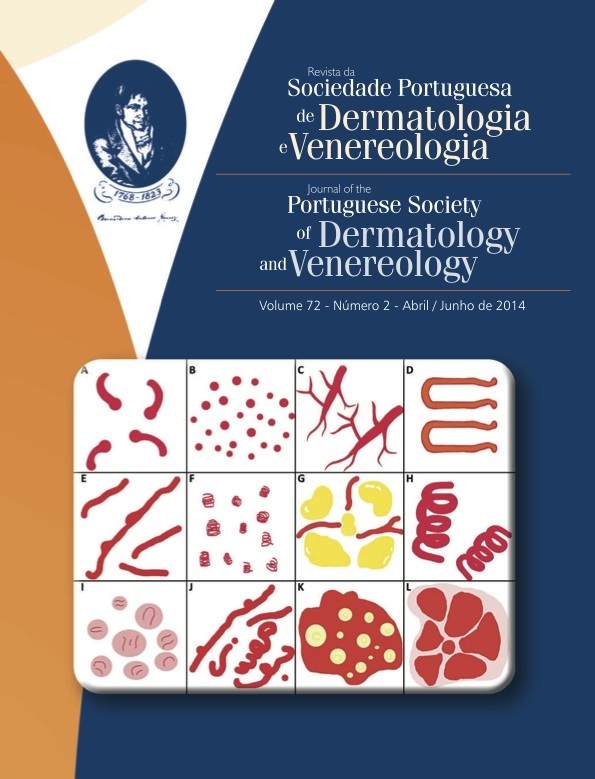STEWART-TREVES SYNDROME – A RARE COMPLICATION OF A COMMON FINDING
Abstract
Stewart-Treves syndrome is a rare entity with bad prognosis. It has been described as a lymphangiosarcoma in lymphedema context. We present the case of a 79-year-old female patient with a history of left breast invasive ductal carcinoma 10 years ago, treated with mastectomy and axillary lymph node dissection, chemotherapy and radiotherapy. She was observed in the Dermatology department for cutaneous changes in her left arm with two months of evolution, which didn’t improve with antibiotherapy. At the physical examination, we observed a high-grade lymphedema with erythematous-violaceous nodules on the anterior inner face of the left arm. A biopsy was performed and the diagnosis of angiosarcoma was established. The patient died one month after by disease’s progression. The awareness of the dermatologic semiology of this entity could lead to an early detection, with a precocious intervention and a better prognosis.
Downloads
References
Stewart FW, Treves N. Lymphangiosarcoma in post mastectomy lymphedema: a report of six cases in elephantiasis chirurgica. Cancer .1948; 1:64-81.
Shon W, Ida CM, Boland-Froemming JM, Rose PS, Folpe A. Cutaneous angiosarcoma arising in massive localized lymphedema of the morbidly obese: a report of five cases and review of the literature. J Cutan Pathol. 2011, 38: 560-4.
Simas A, Matos C, Lopes da Silva R, Brotas V, Teófilo E, Albino JP. Epithelioid angiosarcoma in a patient with Klippel-Trénaunay-Weber syndrome: an unexpected response to therapy. Case Rep Oncol
; 3:148-53
Sánchez-Medina MT, Acosta A, Vilar J, Fernández-Palacios J. Angiosarcoma en linfedema cronico (sindrome de Stewart-Treves). Actas Dermosifiliogr. 2012; 103:545-7.
Woodward A, Ivins J, Soule E. Lymphangiosarcoma arising in chronic lymphedematous extremities. Cancer. 2006; 30:562-72.
Komorowski A, Wysocki W, Mitus J. Angiosarcoma in a chronically lymphedematous leg: an unusual
presentation of Stewart-Treves syndrome. South Med J. 2003; 96: 807-8.
Schwartz RA. Stewart-Treves syndrome. In: Demis DJ, editor. Clinical dermatology. 16th ed. Philadelphia: Harper and Row Inc; 1989. p. 1-6.
Requena L, Sangueza OP. Cutaneous vascular proliferations. Part III. Malignant neoplasms, other
cutaneous neoplasms with significant vascular component, and disorders erroneously considered
as vascular neoplasms. J Am Acad Dermatol. 1998; 38(2 Pt 1):143-75; quiz 176-8.
Fitzpatrick P. Lymphangiosarcoma and breast cancer. Can J Surg. 1969; 12:172-7.
Fodor J, Orosz Z, Szabo E, Sulyok Z, Polgar C, Zaka Z, et al. Angiosarcoma after conservation
treatment for breast carcinoma: our experience and a review of the literature. J Am Acad Dermatol. 2006; 54:499-504.
Durr HR, Pellengahr C, Nerlich A, Baur A, Maier M, Jansson V. Stewart-Treves syndrome as a rare complication of a hereditary lymphedema. Vasa. 2004; 33:42-5.
Rodríguez-Bujaldón A, Vázquez-Bayo M, Galán-Gutiérrez M, Jiménez-Puya R, Vélez García-Nieto
A, Moreno-Giménez JC, et al. Angiosarcoma sobre linfedema crónico. Actas Dermosi- filiogr. 2006; 97:525-8.
Arriagada R, Mouriesse H, Rezvani A, Sarrazin D, Clark RM, DeBoer G, et al. Radiotherapy alone in
breast cancer. Analysis of tumor and lymph node radiation doses and treatment-related complications:
the experience of the Gustave-Roussy Institute and the Princess Margaret Hospital. Radiother Oncol. 1993; 27:1-6.
Mallon E, Powell S, Mortimer P, Ryan TJ. Evidence for altered cell-mediated immunity in postmastectomy lymphoedema. Br J Dermatol. 1997; 137:928-33.
Szolnoky G, Dobozy A, Kemény L. Decongestion improves cell-mediated immunity in postmastectomy arm lymphoedema: a pilot study. J Eur Acad Dermatol Venereol. 2013; 27(12):1579-82
Sharma A, Schwartz RA. Stewart-Treves syndrome: pathogenesis and management. J Am Acad Dermatol. 2012; 67(6):1342-8
Ruocco V, Schwartz RA, Ruocco E. Lymphedema: an immunologically vulnerable site for development of neoplasms. J Am Acad Dermatol. 2002; 47:124-7.
Ruocco V, Brunetti G, Puca RV, Ruocco E. The immunocom-promised district: a unifying concept
for lymphedematous, herpes-infected and otherwise damaged sites. J Eur Acad Dermatol Venereol.
; 23:1364-73.
Stanczyk M, Gewartowska M, Swierkowski M, Grala B, Maruszynski M. Stewart-Treves syndrome angiosarcoma expresses phenotypes of both blood and lymphatic capillaries. Chin Med J. 2013; 126(2):231-7.
Wierzbicka-Hainaut E, Guillet G. Stewart-Treves syndrome (angiosarcoma on lyphoedema): a rare
complication of lymphoedema. Presse Med. 2010; 39(12):1305-8.
Grobmyer S, Daly J, Glotzbach R, Grobmyer A III. Role of surgery in the management of postmastectomy extremity angiosarcoma (Stewart-Treves syndrome). J Surg Oncol. 2000; 73:182-8.
Budd GT. Management of Angiosarcoma. Curr Oncol Rep. 2002 4:515.
Perez MC, Padhya TA, Messina JL, Jackson RS, Gonzalez RJ, Bui MM, et al. Cutaneous angiosarcoma: a single-institution experience. Ann Surg Oncol. 2013; 20(11):3391-7.
All articles in this journal are Open Access under the Creative Commons Attribution-NonCommercial 4.0 International License (CC BY-NC 4.0).








